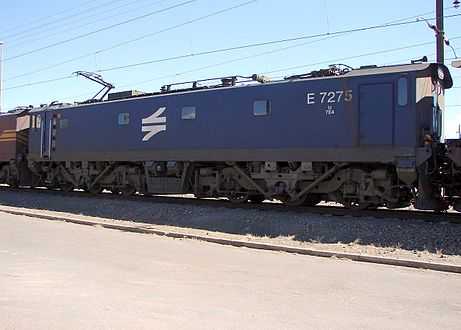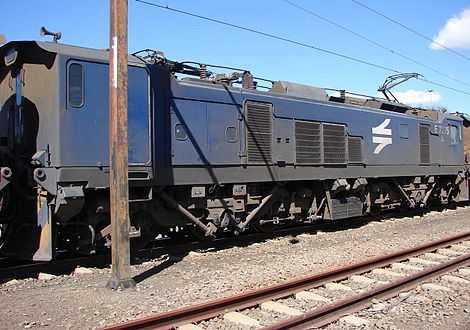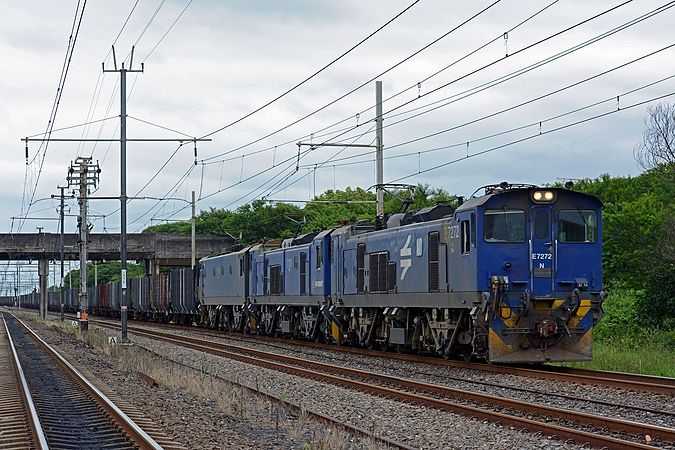South African Class 7E4
| South African Class 7E4 ex South African Class 7E3 Series 1 & 2 | |
|---|---|
|
E7272 heading empty timber wagons through Nsezi near Richards Bay, 8 December 2013 | |
| Type and origin | |
| Power type | Electric |
| Designer | Hitachi |
| Builder | Dorbyl |
| Model | Hitachi 7E3 |
| Build date |
1983-1984 (7E3 Series 1) 1984-1985 (7E3 Series 2) |
| Total produced | 85 |
| Rebuilder | Transwerk |
| Rebuild date | 2000-2003 |
| Number rebuilt | 17 |
| Specifications | |
| UIC classification | Co-Co |
| Gauge | 3 ft 6 in (1,067 mm) Cape gauge |
| Bogies | 4.060 m (13 ft 3.8 in) wheelbase |
| Wheel diameter | 1,220 mm (48 in) |
| Wheelbase | 13.46 m (44 ft 1.9 in) |
| Length | 18.43 m (60 ft 5.6 in) |
| Width | 2.906 m (9 ft 6.4 in) |
| Height | 4.18 m (13 ft 8.6 in) pantographs down |
| Axle load | 21,420 kg (21.1 long tons) |
| Locomotive weight | 123,500 kg (121.5 long tons) |
| Current collection method | Pantographs |
| Traction motors | Six HS 1054 GR |
| Transmission | 16/94 gear ratio |
| Performance figures | |
| Maximum speed | 100 km/h (62 mph) |
| Power output |
Per motor: 525 kW (704 hp) 1 hour 500 kW (670 hp) continuous Total: 3,150 kW (4,220 hp) 1 hour 3,000 kW (4,000 hp) continuous |
| Tractive effort |
450 kN (100,000 lbf) starting 319 kN (72,000 lbf) 1 hour 300 kN (67,000 lbf) continuous [1] |
| Locomotive brake | Air & Rheostatic [2][3] |
| Train brakes | Air & Vacuum |
| Career | |
| Operator(s) |
South African Railways Spoornet Transnet Freight Rail |
| Class | Class 7E4 [3] |
| Power class | 25 kV AC |
| Number in class | 17 |
| Number(s) | E7260-E7276 |
| Delivered | 2001 |
| First run | 2001 |
The South African Class 7E4 of 2001 is a South African electric locomotive from the Spoornet era.
In 1983 and 1984 the South African Railways placed sixty Class 7E3, Series 1 electric locomotives with a Co-Co wheel arrangement in mainline service. These were followed by another twenty-five Class 7E3, Series 2 locomotives in 1984 and 1985. Beginning in 2000 Spoornet rebuilt seventeen of these dual cab locomotives to single cab locomotives and reclassified them to Class 7E4.[3]
Manufacturers
The 25 kV AC Class 7E3 electric locomotives were designed for the South African Railways (SAR) by Hitachi and built in South Africa by Dorbyl, who also supplied the mechanical components.[1][2]
Sixty Series 1 locomotives were delivered by Dorbyl in 1983 and 1984, numbered in the range from E7216 to E7275, and twenty-five Series 2 locomotives in 1984 and 1985, numbered in the range from E7276 to E7300. Like Union Carriage and Wagon, Dorbyl did not allocate builder’s numbers to the locomotives it built for the SAR, but used the SAR unit numbers for their record keeping.[1]
Modification and reclassification
Control of traction and rheostatic braking on these locomotives is by stepless solid-state electronics. The electrical equipment was designed for high power factor operation, obtained by the switching in of power-factor correction capacitors.[2]
In the period from the early 1990s until about 2007 various modifications to improve downhill braking capacity were done to the Coalink line's Hitachi-designed locomotives. The first set of upgrades was done on the fifty Class 7E1 locomotives.[3]
Beginning in 2000, seventeen Class 7E3 locomotives, sixteen Series 1, numbered in the range from E7260 to E7275, and one Series 2, number E7276, underwent significant modifications. This included the installation of Hitachi micro-processor controls with improved rheostatic brakes, auxiliary inverters designed and built by Fuji Electric, Thelma and Cutler-Hammer rheostat grids, fans by Donkin Fans in Port Elizabeth, and conversion from double cab to single cab since the cab space was required for some of the new equipment that was installed. These single cab locomotives were reclassified to Class 7E4 and the first entered service early in 2001.[3][4]
Service
Since 1978, 25 kV AC was introduced on all new mainline electrification projects bar one, the exception being the Orex iron ore line from Sishen to Saldanha, where 50 kV AC is used. The Class 7E4 locomotives all serve on the 25 kV AC Coalink line from Ermelo via Vryheid to the Richards Bay Coal Terminal.[2][3]
The Blue Train
In the SAR and Spoornet eras, when the official liveries were Gulf Red and yellow whiskers for the SAR, and initially orange and later maroon for Spoornet, many selected electric locomotives and some diesel-electrics were painted blue for use with the Blue Train, but without altering the layout of the various paint schemes. Blue Train locomotives were therefore blue with yellow whiskers in the SAR era, blue with the Spoornet logo and the name "SPOORNET" in Spoornet’s orange era, and blue with the Spoornet logo but without the name "SPOORNET" in Spoornet’s maroon era. Later, in Spoornet’s blue era, there was no need for a separate Blue Train livery, while in the Transnet Freight Rail (TFR) era one Class 14E and the surviving Class 14E1 electric locomotives were eventually repainted in blue during 2012 for use with the Blue Train.[3][5][6]
While it is doubtful that the intention was to have a Class 7E4 in blue train livery for blue train hauling on the Richards Bay line, the ones observed, numbers E7272 and E7275, were nevertheless painted in Spoornet’s maroon era Blue Train livery after being rebuilt, possibly to make them easier to identify at a glance.[6]
Sides illustrated
The following pictures, both of no. E7275 at Vryheid in KwaZulu-Natal on 16 August 2007, illustrate both sides of the Class 7E4.
-

Left side
-

Right side
See also
- Electric locomotive numbering and classification
- List of South African locomotive classes
- South African Class 7E3, Series 1
- South African Class 7E3, Series 2
- South African locomotive history
References
|
- ↑ 1.0 1.1 1.2 South African Railways Index and Diagrams Electric and Diesel Locomotives, 610mm and 1065mm Gauges, Ref LXD 14/1/100/20, 28 January 1975, as amended
- ↑ 2.0 2.1 2.2 2.3 Paxton, Leith; Bourne, David (1985). Locomotives of the South African Railways (1st ed.). Cape Town: Struik. pp. 129–131. ISBN 0869772112.
- ↑ 3.0 3.1 3.2 3.3 3.4 3.5 3.6 Middleton, John N. (2002). Railways of Southern Africa Locomotive Guide - 2002 (as amended by Combined Amendment List 4, January 2009) (2nd, Dec 2002 ed.). Herts, England: Beyer-Garratt Publications. pp. 50, 61.
- ↑ Information obtained from Transnet engineers and drivers
- ↑ E1973 in blue based on orange livery
- ↑ 6.0 6.1 E1951 in blue based on maroon livery
